Measurement of Thermal Conductivity and Thermal Diffusivity of Porcine and Bovine Kidney Tissues at Supraphysiological Temperatures up to 93 °C
Abstract
1. Introduction
2. Experimental Procedure and Methods for Data Analysis
2.1. Experimental Setup
2.2. Tissue Preparation
2.3. Heating Protocol and Measurement of the Thermal Properties
2.4. Measurement Uncertainty Evaluation
2.5. Thermal Property Modeling
2.6. Statistical Analysis
3. Results
3.1. Measurement System Validation
3.2. Thermal Properties of Porcine Kidney
3.3. Thermal Properties of Bovine Kidney
3.4. Comparison of the Thermal Properties of Porcine and Bovine Kidney Tissues
4. Discussion
Author Contributions
Funding
Data Availability Statement
Conflicts of Interest
References
- McDonald, M.; Lochhead, S.; Chopra, R.; Bronskill, M.J. Multi-Modality Tissue-Mimicking Phantom for Thermal Therapy. Phys. Med. Biol. 2004, 49, 2767. [Google Scholar] [CrossRef] [PubMed]
- Pollacco, D.A.; Farina, L.; Wismayer, P.S.; Farrugia, L.; Sammut, C.V. Characterization of the Dielectric Properties of Biological Tissues and Their Correlation to Tissue Hydration. IEEE Trans. Dielectr. Electr. Insul. 2018, 25, 2191–2197. [Google Scholar] [CrossRef]
- Ito, K.; Furuya, K.; Okano, Y.; Hamada, L. Development and Characteristics of a Biological Tissue-Equivalent Phantom for Microwaves. Electron. Commun. Jpn. 2001, 84, 67–77. [Google Scholar] [CrossRef]
- Lanka, P.; Bianchi, L.; Farina, A.; De Landro, M.; Pifferi, A.; Saccomandi, P. Estimation of Porcine Pancreas Optical Properties in the 600–1100 Nm Wavelength Range for Light-Based Therapies. Sci. Rep. 2022, 12, 14300. [Google Scholar] [CrossRef] [PubMed]
- Buck, W.; Rudtsch, S. Thermal Properties. In Springer Handbook of Materials Measurement Methods; Czichos, H., Saito, T., Smith, L., Eds.; Springer: Berlin/Heidelberg, Germany, 2006; pp. 399–429. ISBN 978-3-540-30300-8. [Google Scholar]
- Lopresto, V.; Pinto, R.; Farina, L.; Cavagnaro, M. Treatment Planning in Microwave Thermal Ablation: Clinical Gaps and Recent Research Advances. Int. J. Hyperth. 2017, 33, 83–100. [Google Scholar] [CrossRef]
- Silva, N.P.; Bottiglieri, A.; Conceição, R.C.; O’Halloran, M.; Farina, L. Characterisation of Ex Vivo Liver Thermal Properties for Electromagnetic-Based Hyperthermic Therapies. Sensors 2020, 20, 3004. [Google Scholar] [CrossRef] [PubMed]
- Farina, L.; Sumser, K.; van Rhoon, G.; Curto, S. Thermal Characterization of Phantoms Used for Quality Assurance of Deep Hyperthermia Systems. Sensors 2020, 20, 4549. [Google Scholar] [CrossRef]
- Bianchi, L.; Cavarzan, F.; Ciampitti, L.; Cremonesi, M.; Grilli, F.; Saccomandi, P. Thermophysical and Mechanical Properties of Biological Tissues as a Function of Temperature: A Systematic Literature Review. Int. J. Hyperth. 2022, 39, 297–340. [Google Scholar] [CrossRef]
- Jasinski, M.; Bielinska, M.; Siekiera, J.; Kamecki, K.; Salagierski, M. Ultrasound-Guided Percutaneous Thermal Ablation of Renal Cancers—In Search for the Ideal Tumour. Cancers 2023, 15, 518. [Google Scholar] [CrossRef]
- Nesvadba, P. A New Transient Method of the Measurement of Temperature Dependent Thermal Diffusivity. J. Phys. D Appl. Phys. 1982, 15, 725–738. [Google Scholar] [CrossRef]
- Mohammadi, A.; Bianchi, L.; Asadi, S.; Saccomandi, P. Measurement of Ex Vivo Liver, Brain and Pancreas Thermal Properties as Function of Temperature. Sensors 2021, 21, 4236. [Google Scholar] [CrossRef] [PubMed]
- Nikfarjam, M.; Muralidharan, V.; Christophi, C. Mechanisms of Focal Heat Destruction of Liver Tumors. J. Surg. Res. 2005, 127, 208–223. [Google Scholar] [CrossRef]
- Roti Roti, J.L. Cellular Responses to Hyperthermia (40–46 °C): Cell Killing and Molecular Events. Int. J. Hyperth. 2008, 24, 3–15. [Google Scholar] [CrossRef]
- Ezzat, M.A. The Effects of Thermal and Mechanical Material Properties on Tumorous Tissue during Hyperthermia Treatment. J. Therm. Biol. 2020, 92, 102649. [Google Scholar] [CrossRef] [PubMed]
- Jaque, D.; Martínez Maestro, L.; del Rosal, B.; Haro-Gonzalez, P.; Benayas, A.; Plaza, J.L.; Martín Rodríguez, E.; García Solé, J. Nanoparticles for Photothermal Therapies. Nanoscale 2014, 6, 9494–9530. [Google Scholar] [CrossRef] [PubMed]
- Kok, H.P.; Cressman, E.N.K.; Ceelen, W.; Brace, C.L.; Ivkov, R.; Grüll, H.; ter Haar, G.; Wust, P.; Crezee, J. Heating Technology for Malignant Tumors: A Review. Int. J. Hyperth. 2020, 37, 711–741. [Google Scholar] [CrossRef]
- Chu, K.F.; Dupuy, D.E. Thermal Ablation of Tumours: Biological Mechanisms and Advances in Therapy. Nat. Rev. Cancer 2014, 14, 199–208. [Google Scholar] [CrossRef] [PubMed]
- Schildkopf, P.; Ott, O.J.; Frey, B.; Wadepohl, M.; Sauer, R.; Fietkau, R.; Gaipl, U.S. Biological Rationales and Clinical Applications of Temperature Controlled Hyperthermia—Implications for Multimodal Cancer Treatments. Curr. Med. Chem. 2010, 17, 3045–3057. [Google Scholar] [CrossRef]
- Behrouzkia, Z.; Joveini, Z.; Keshavarzi, B.; Eyvazzadeh, N.; Aghdam, R.Z. Hyperthermia: How Can It Be Used? Oman Med. J. 2016, 31, 89–97. [Google Scholar] [CrossRef]
- Rossmann, C.; Haemmerich, D. Review of Temperature Dependence of Thermal Properties, Dielectric Properties, and Perfusion of Biological Tissues at Hyperthermic and Ablation Temperatures. Crit. Rev. Biomed. Eng. 2014, 42, 467–492. [Google Scholar] [CrossRef]
- Nishikawa, H.; Kimura, T.; Kita, R.; Osaki, Y. Radiofrequency Ablation for Hepatocellular Carcinoma. Int. J. Hyperth. 2013, 29, 558–568. [Google Scholar] [CrossRef] [PubMed]
- Nakada, S.Y.; Jerde, T.J.; Warner, T.F.; Wright, A.S.; Haemmerich, D.; Mahvi, D.M.; Lee, F.T. Bipolar Radiofrequency Ablation of the Kidney: Comparison with Monopolar Radiofrequency Ablation. J. Endourol. 2003, 17, 927–933. [Google Scholar] [CrossRef] [PubMed]
- Li, M.; Yu, X.; Liang, P.; Liu, F.; Dong, B.; Zhou, P. Percutaneous Microwave Ablation for Liver Cancer Adjacent to the Diaphragm. Int. J. Hyperth. 2012, 28, 218–226. [Google Scholar] [CrossRef]
- Lubner, M.G.; Brace, C.L.; Hinshaw, J.L.; Lee, F.T. Microwave Tumor Ablation: Mechanism of Action, Clinical Results, and Devices. J. Vasc. Interv. Radiol. 2010, 21, S192–S203. [Google Scholar] [CrossRef] [PubMed]
- Korganbayev, S.; Orrico, A.; Bianchi, L.; Paloschi, D.; Wolf, A.; Dostovalov, A.; Saccomandi, P. PID Controlling Approach Based on FBG Array Measurements for Laser Ablation of Pancreatic Tissues. IEEE Trans. Instrum. Meas. 2021, 70, 7006409. [Google Scholar] [CrossRef]
- Korganbayev, S.; Orrico, A.; Bianchi, L.; De Landro, M.; Wolf, A.; Dostovalov, A.; Saccomandi, P. Closed-Loop Temperature Control Based on Fiber Bragg Grating Sensors for Laser Ablation of Hepatic Tissue. Sensors 2020, 20, 6496. [Google Scholar] [CrossRef]
- Asadi, S.; Bianchi, L.; De Landro, M.; Korganbayev, S.; Schena, E.; Saccomandi, P. Laser-induced Optothermal Response of Gold Nanoparticles: From a Physical Viewpoint to Cancer Treatment Application. J. Biophotonics 2021, 14, e202000161. [Google Scholar] [CrossRef]
- Kennedy, J.E. High-Intensity Focused Ultrasound in the Treatment of Solid Tumours. Nat. Rev. Cancer 2005, 5, 321–327. [Google Scholar] [CrossRef]
- Stauffer, P.R.; Goldberg, S.N. Introduction: Thermal Ablation Therapy. Int. J. Hyperth. 2004, 20, 671–677. [Google Scholar] [CrossRef]
- Zhmakin, A.I. Heat Transfer In Vivo: Phenomena and Models. In Handbook of Thermal Science and Engineering; Springer International Publishing: Cham, Switzerland, 2018; pp. 2333–2379. ISBN 978-3-319-26695-4. [Google Scholar]
- Welch, A.J.; Gemert, M.J.C. Optical-Thermal Response of Laser-Irradiated Tissue; Welch, A.J., van Gemert, M.J.C., Eds.; Springer: Dordrecht, The Netherlands, 2011; ISBN 978-90-481-8830-7. [Google Scholar]
- Bianchi, L.; Bontempi, M.; De Simone, S.; Franceschet, M.; Saccomandi, P. Temperature Dependence of Thermal Properties of Ex Vivo Porcine Heart and Lung in Hyperthermia and Ablative Temperature Ranges. Ann. Biomed. Eng. 2023, 51, 1181–1198, Erratum in Ann. Biomed. Eng. 2023, 51, 1119. [Google Scholar] [CrossRef]
- Bhavaraju, N.C.; Valvano, J.W. Thermophysical Properties of Swine Myocardium. Int. J. Thermophys. 1999, 20, 665–676. [Google Scholar] [CrossRef]
- Valvano, J.W.; Cochran, J.R.; Diller, K.R. Thermal Conductivity and Diffusivity of Biomaterials Measured with Self-Heated Thermistors. Int. J. Thermophys. 1985, 6, 301–311. [Google Scholar] [CrossRef]
- Hayes, L.J.; Valvano, J.W. Steady-State Analysis of Self-Heated Thermistors Using Finite Elements. J. Biomech. Eng. 1985, 107, 77–80. [Google Scholar] [CrossRef] [PubMed]
- Lopresto, V.; Argentieri, A.; Pinto, R.; Cavagnaro, M. Temperature Dependence of Thermal Properties of Ex Vivo Liver Tissue up to Ablative Temperatures. Phys. Med. Biol. 2019, 64, 105016. [Google Scholar] [CrossRef] [PubMed]
- Silva, N.P.; Bottiglieri, A.; Conceicao, R.C.; O’Halloran, M.; Farina, L. Thermal Properties of Ex Vivo Biological Tissue at Room and Body Temperature. In Proceedings of the 2020 14th European Conference on Antennas and Propagation (EuCAP), Copenhagen, Denmark, 15–20 March 2020; pp. 1–5. [Google Scholar]
- Bianchi, L.; Asadi, S.; De Landro, M.; Korganbayev, S.; Saccomandi, P. Measurement of Thermal Properties of Biological Tissues and Tissue-Mimicking Phantom with a Dual-Needle Sensor. In Proceedings of the 2022 IEEE International Symposium on Medical Measurements and Applications (MeMeA), Messina, Italy, 22–24 June 2022; pp. 1–6. [Google Scholar]
- Silva, N.P.; Bottiglieri, A.; Porter, E.; O’Halloran, M.; Farina, L. Evaluation of Thermal Properties of Ex Vivo Kidney up to Ablative Temperatures. IFMBE Proc. 2021, 80, 537–543. [Google Scholar]
- Finco, D.R. Chapter 17—Kidney Function. In Clinical Biochemistry of Domestic Animals, 5th ed.; Kaneko, J.J., Harvey, J.W., Bruss, M.L., Eds.; Academic Press: San Diego, CA, USA, 1997; pp. 441–484. ISBN 978-0-12-396305-5. [Google Scholar]
- Park, B.K.; Shen, S.-H.; Fujimori, M.; Wang, Y. Thermal Ablation for Renal Cell Carcinoma: Expert Consensus from the Asian Conference on Tumor Ablation. Korean J. Radiol. 2021, 22, 1490–1496. [Google Scholar] [CrossRef]
- Ljungberg, B.; Albiges, L.; Abu-Ghanem, Y.; Bensalah, K.; Dabestani, S.; Fernández-Pello, S.; Giles, R.H.; Hofmann, F.; Hora, M.; Kuczyk, M.A.; et al. European Association of Urology Guidelines on Renal Cell Carcinoma: The 2019 Update. Eur. Urol. 2019, 75, 799–810. [Google Scholar] [CrossRef]
- Stouffer, G.A.; DiBona, G.F.; Patel, A.; Kaul, P.; Hinderliter, A.L. Catheter-Based Renal Denervation in the Treatment of Resistant Hypertension. J. Mol. Cell. Cardiol. 2013, 62, 18–23. [Google Scholar] [CrossRef]
- Dragonu, I.; de Oliveira, P.L.; Laurent, C.; Mougenot, C.; Grenier, N.; Moonen, C.T.W.; Quesson, B. Non-Invasive Determination of Tissue Thermal Parameters from High Intensity Focused Ultrasound Treatment Monitored by Volumetric MRI Thermometry. NMR Biomed. 2009, 22, 843–851. [Google Scholar] [CrossRef]
- Cornelis, F.; Grenier, N.; Moonen, C.T.; Quesson, B. In Vivo Characterization of Tissue Thermal Properties of the Kidney during Local Hyperthermia Induced by MR-Guided High-Intensity Focused Ultrasound. NMR Biomed. 2011, 24, 799–806. [Google Scholar] [CrossRef]
- Palumbo, G.; Iadicicco, A.; Tosi, D.; Verze, P.; Carlomagno, N.; Tammaro, V.; Ippolito, J.; Campopiano, S. Temperature Profile of Ex-Vivo Organs during Radio Frequency Thermal Ablation by Fiber Bragg Gratings. J. Biomed. Opt. 2016, 21, 117003. [Google Scholar] [CrossRef]
- Mohammadi, A.; Bianchi, L.; Korganbayev, S.; De Landro, M.; Saccomandi, P. Thermomechanical Modeling of Laser Ablation Therapy of Tumors: Sensitivity Analysis and Optimization of Influential Variables. IEEE Trans. Biomed. Eng. 2021, 69, 302–313. [Google Scholar] [CrossRef] [PubMed]
- Payne, S.J.; Peng, T.; O’Neill, D.P. Mathematical Modeling of Thermal Ablation. Crit. Rev. Biomed. Eng. 2010, 38, 21–30. [Google Scholar] [CrossRef]
- Deuflhard, P.; Schiela, A.; Weiser, M. Mathematical Cancer Therapy Planning in Deep Regional Hyperthermia. Acta Numer. 2012, 21, 307–378. [Google Scholar] [CrossRef]
- Shafirstein, G.; Feng, Y. The Role of Mathematical Modelling in Thermal Medicine. Int. J. Hyperth. 2013, 29, 259–261. [Google Scholar] [CrossRef]
- Wehner, M.; Betz, P.; Aden, M. Influence of Laser Wavelength and Beam Profile on the Coagulation Depth in a Soft Tissue Phantom Model. Lasers Med. Sci. 2019, 34, 335–341. [Google Scholar] [CrossRef] [PubMed]
- Erdogan, T. Fiber Grating Spectra. J. Light. Technol. 1997, 15, 1277–1294. [Google Scholar] [CrossRef]
- Bianchi, L.; Korganbayev, S.; Orrico, A.; De Landro, M.; Saccomandi, P. Quasi-Distributed Fiber Optic Sensor-Based Control System for Interstitial Laser Ablation of Tissue: Theoretical and Experimental Investigations. Biomed. Opt. Express 2021, 12, 2841–2858. [Google Scholar] [CrossRef] [PubMed]
- Bianchi, L.; Mooney, R.; Cornejo, Y.; Hyde, C.; Schena, E.; Berlin, J.M.; Aboody, K.; Saccomandi, P. Fiber Bragg Grating Sensors-Based Thermometry of Gold Nanorod-Enhanced Photothermal Therapy in Tumor Model. IEEE Sens. J. 2022, 22, 11297–11306. [Google Scholar] [CrossRef]
- Bristow, K.L.; Kluitenberg, G.J.; Horton, R. Measurement of Soil Thermal Properties with a Dual-Probe Heat-Pulse Technique. Soil Sci. Soc. Am. J. 1994, 58, 1288–1294. [Google Scholar] [CrossRef]
- Blackwell, J.H. A Transient-Flow Method for Determination of Thermal Constants of Insulating Materials in Bulk Part I—Theory. J. Appl. Phys. 2004, 25, 137–144. [Google Scholar] [CrossRef]
- Available online: https://www.metergroup.com/en/meter-environment/measurement-insights/thermal-properties-why-tempos-method-outperforms-other (accessed on 12 July 2023).
- de Vries, D.A. A nonstationary method for determining thermal conductivity of soil in situ. Soil Sci. 1952, 73, 83–90. [Google Scholar] [CrossRef]
- JCGM 100:2008; Evaluation of Measurement Data—Guide to the Expression of Uncertainty in Measurement. Joint Committee for Guides in Metrology: Sèvres, France, 2008; pp. 18–21.
- TEMPOS—Thermal Properties Analyser Manual. Available online: https://www.metergroup.com/environment/products/tempos/ (accessed on 12 July 2023).
- Guntur, S.R.; Lee, K.I.L.; Paeng, D.-G.; Coleman, A.J.; Choi, M.J. Temperature-Dependent Thermal Properties of ExVivo Liver Undergoing Thermal Ablation. Ultrasound Med. Biol. 2013, 39, 1771–1784. [Google Scholar] [CrossRef] [PubMed]
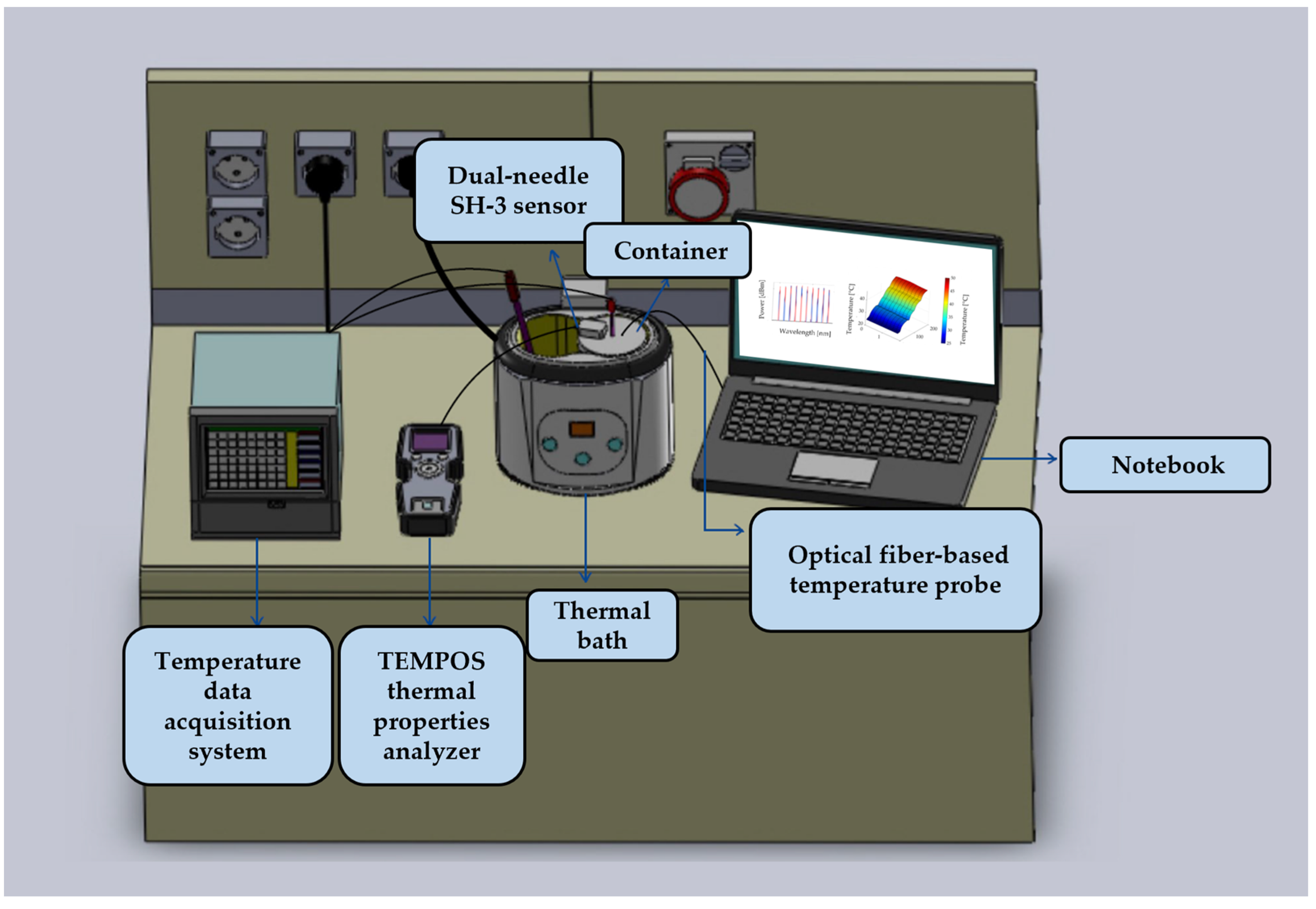
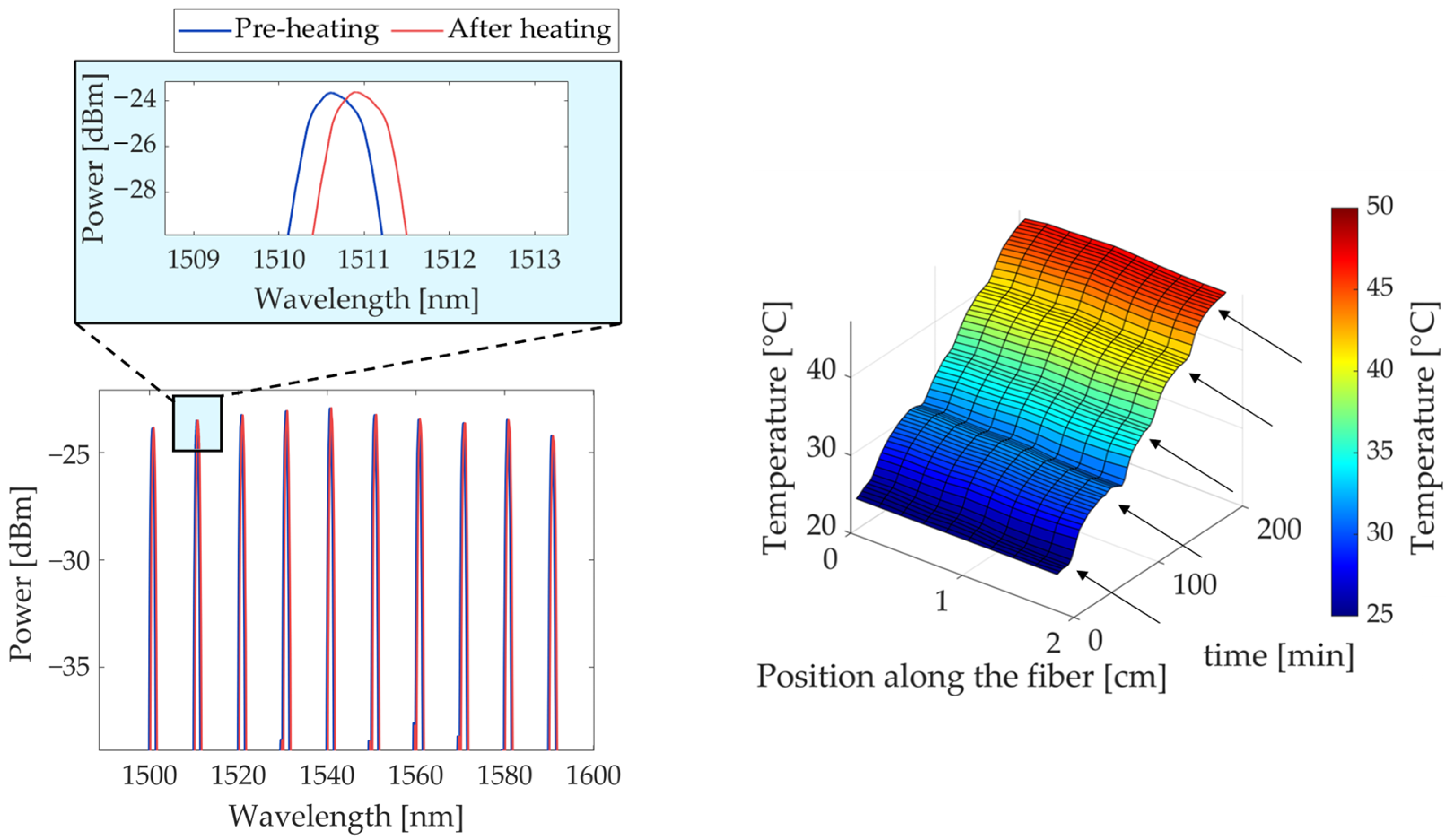
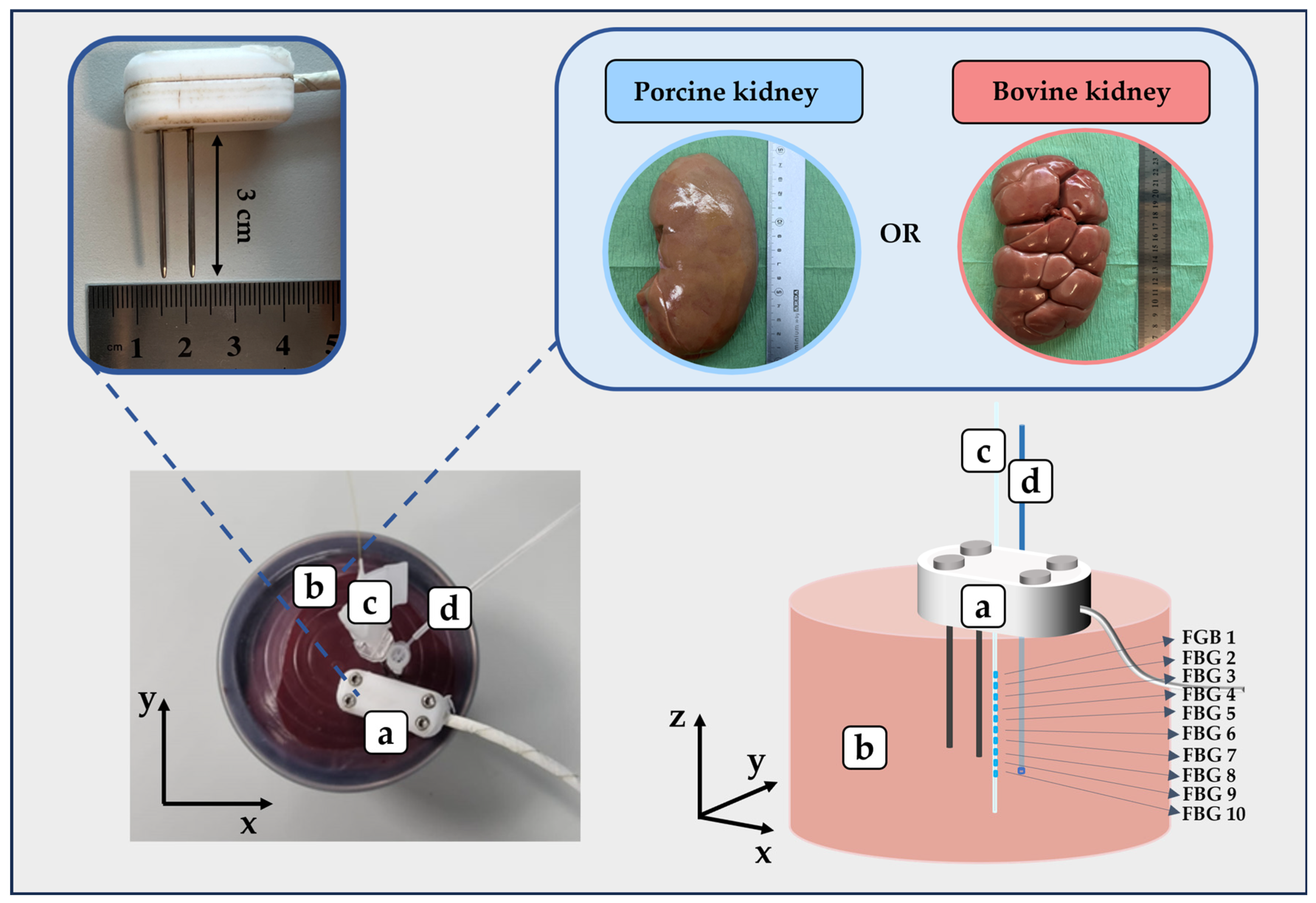
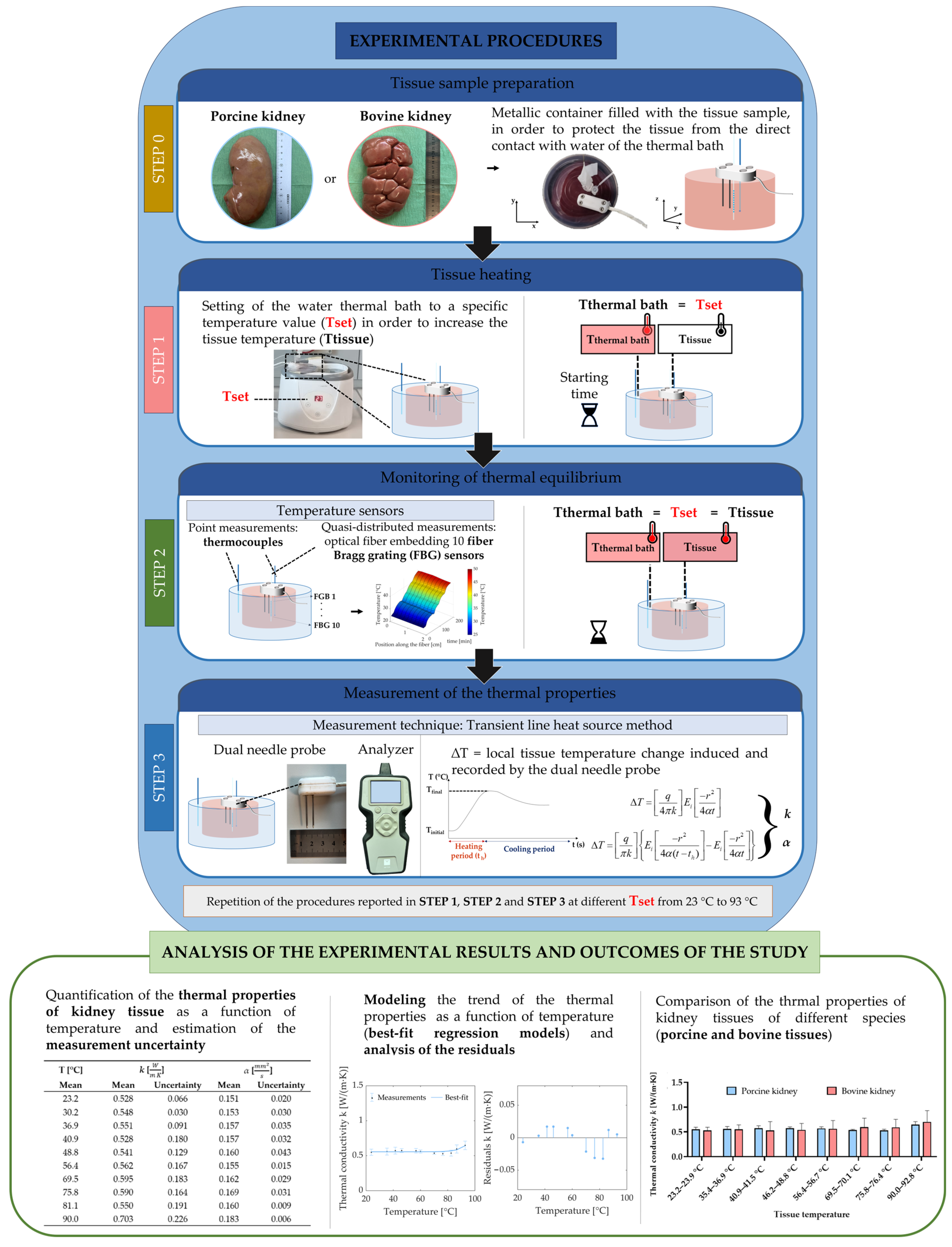
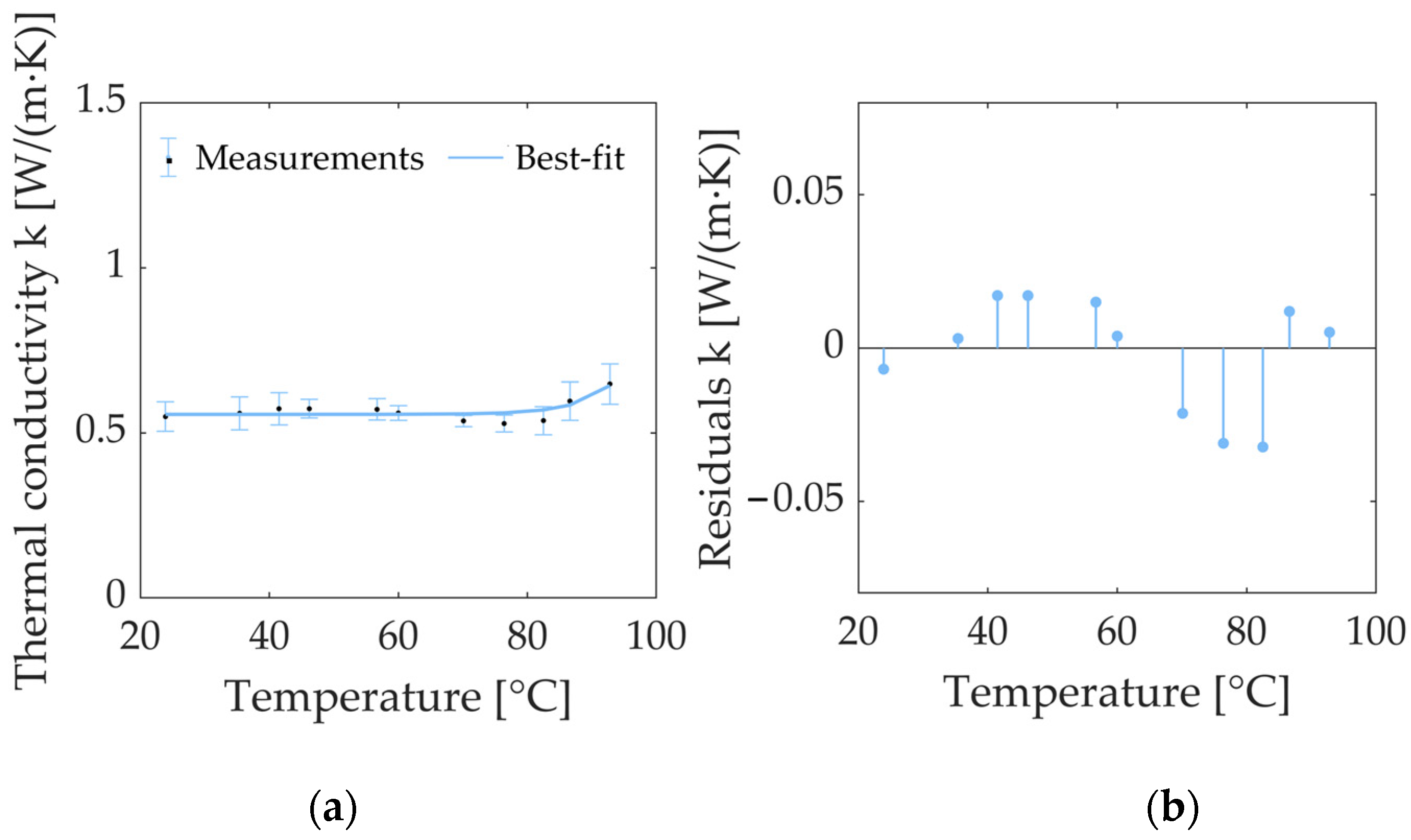
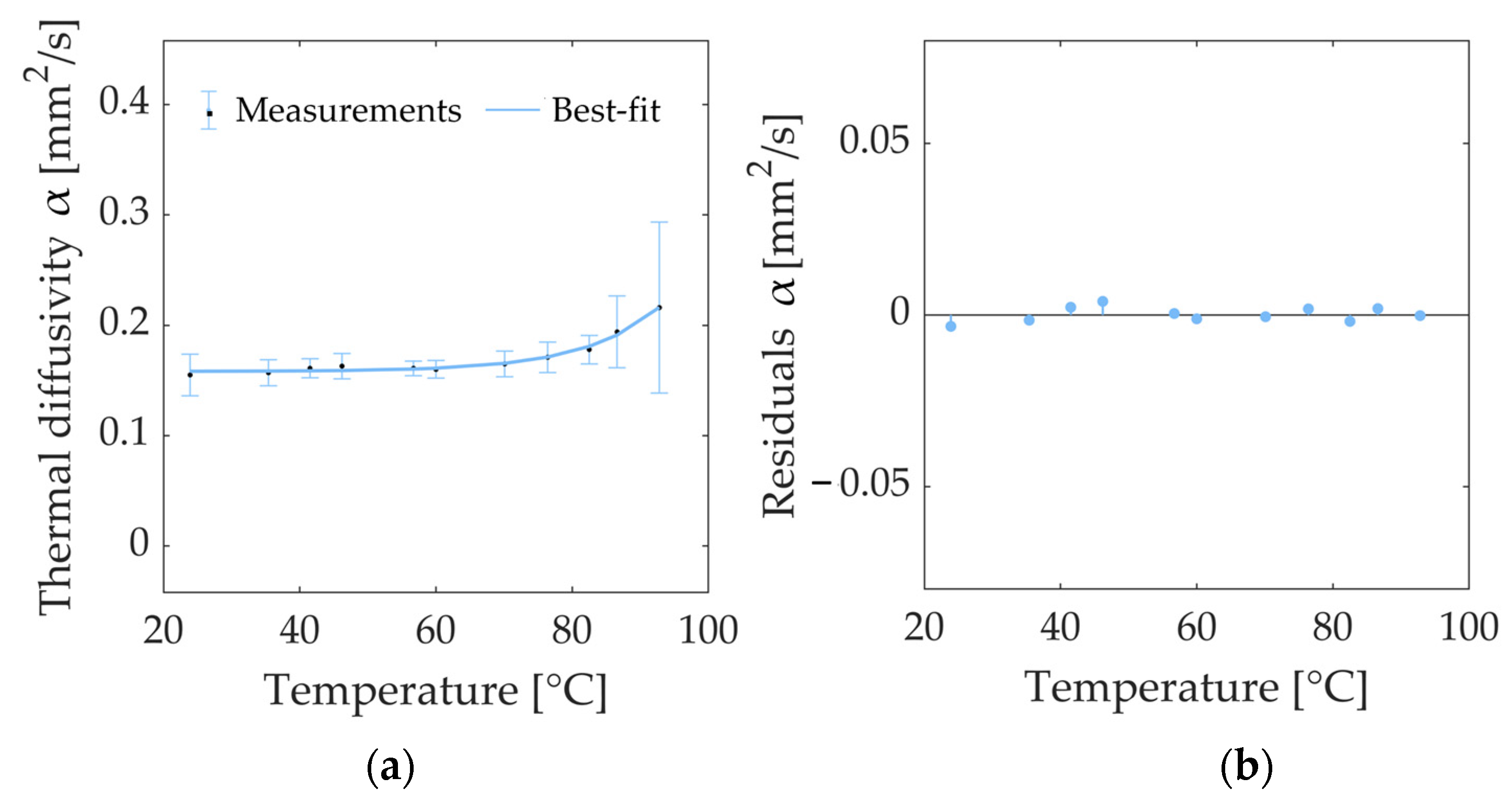
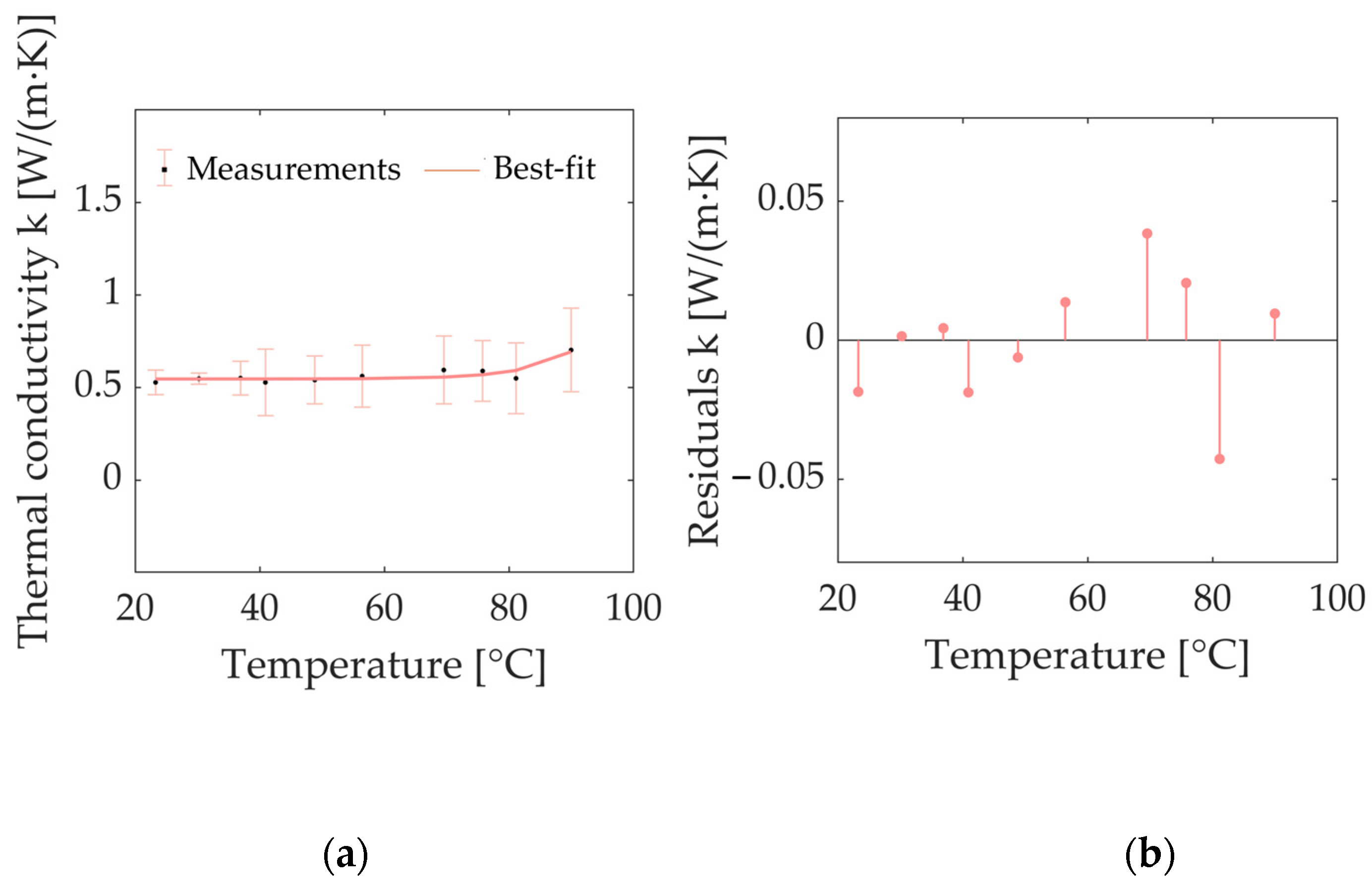
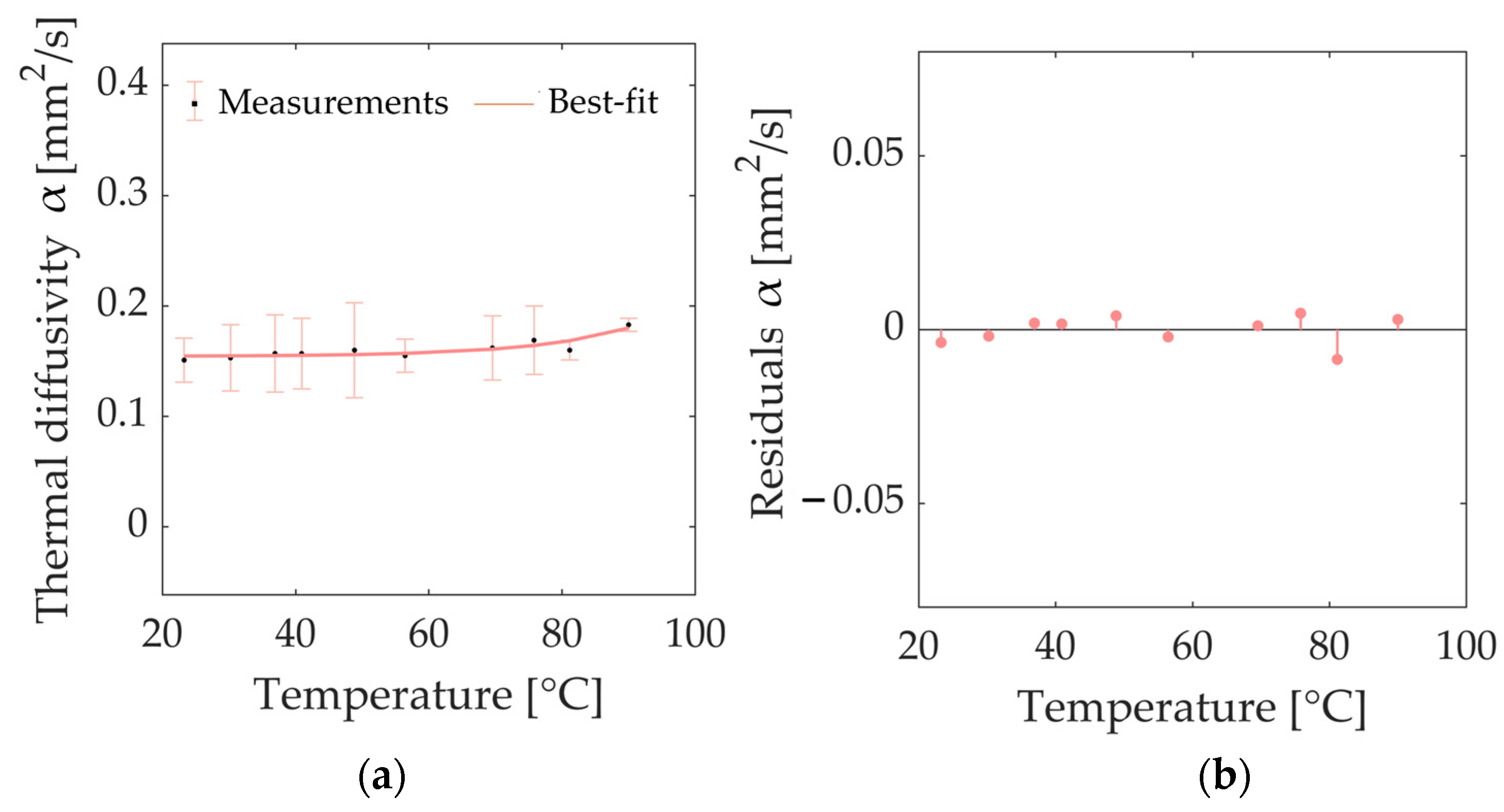
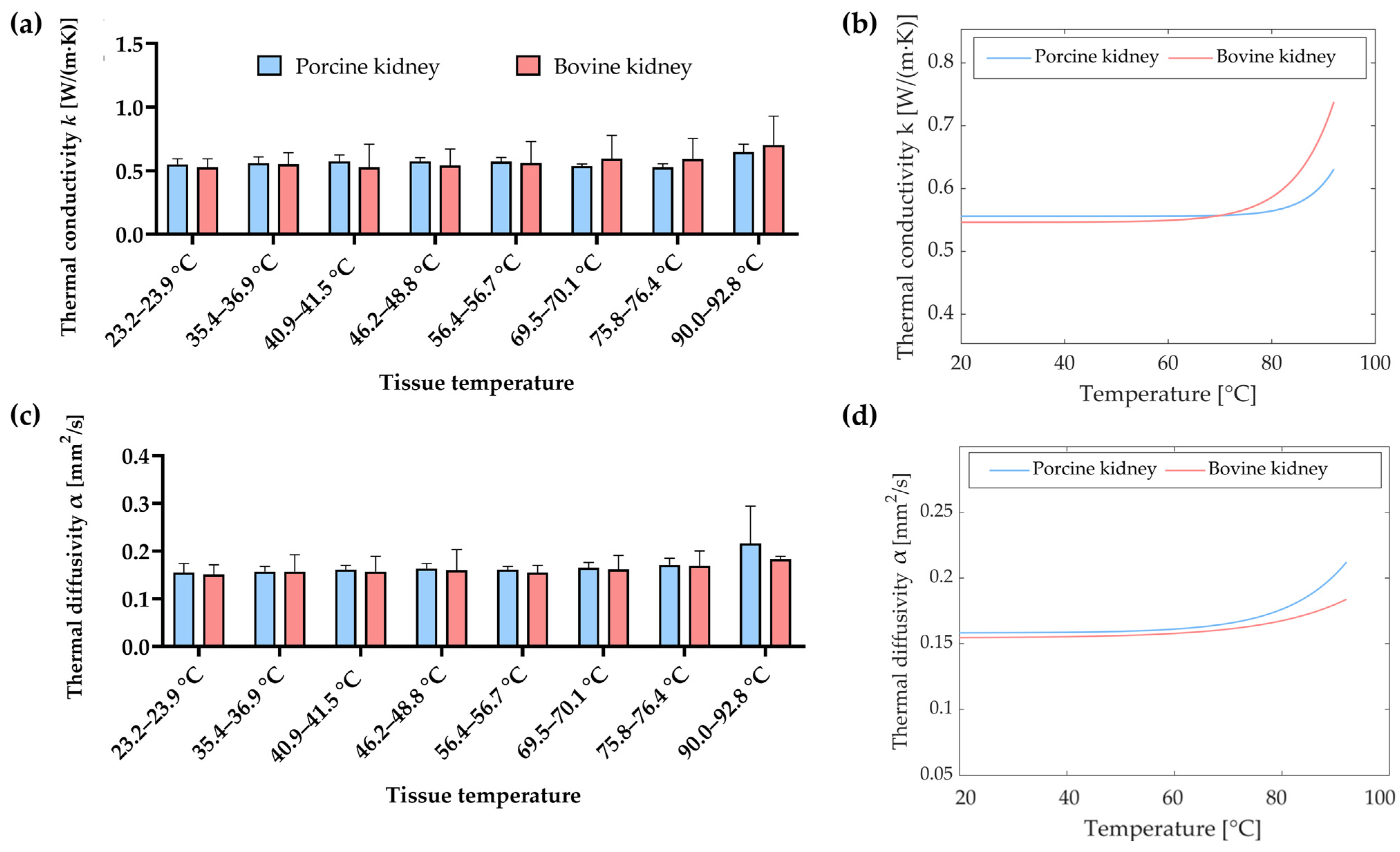
| T [°C] | ||||
|---|---|---|---|---|
| Mean | Mean | Uncertainty | Mean | Uncertainty |
| 23.9 | 0.549 | 0.045 | 0.155 | 0.019 |
| 35.4 | 0.559 | 0.050 | 0.157 | 0.011 |
| 41.5 | 0.573 | 0.050 | 0.161 | 0.009 |
| 46.2 | 0.573 | 0.030 | 0.163 | 0.011 |
| 56.7 | 0.571 | 0.033 | 0.161 | 0.007 |
| 60.0 | 0.560 | 0.022 | 0.160 | 0.008 |
| 70.1 | 0.536 | 0.017 | 0.165 | 0.011 |
| 76.4 | 0.528 | 0.026 | 0.171 | 0.014 |
| 82.3 | 0.527 | 0.080 | 0.178 | 0.016 |
| 86.6 | 0.596 | 0.058 | 0.194 | 0.033 |
| 92.8 | 0.648 | 0.061 | 0.216 | 0.078 |
| Thermal Property | a | b | c | R2 |
|---|---|---|---|---|
| Thermal conductivity, k [W/(m·K)] | 0.5559 | 4.096 × 10−9 | 0.1818 | 0.6824 |
| Thermal diffusivity, α [mm2/s] | 0.1582 | 1.218 × 10−5 | 0.09125 | 0.9875 |
| T [°C] | ||||
|---|---|---|---|---|
| Mean | Mean | Uncertainty | Mean | Uncertainty |
| 23.2 | 0.528 | 0.066 | 0.151 | 0.020 |
| 30.2 | 0.548 | 0.030 | 0.153 | 0.030 |
| 36.9 | 0.551 | 0.091 | 0.157 | 0.035 |
| 40.9 | 0.528 | 0.180 | 0.157 | 0.032 |
| 48.8 | 0.541 | 0.129 | 0.160 | 0.043 |
| 56.4 | 0.562 | 0.167 | 0.155 | 0.015 |
| 69.5 | 0.595 | 0.183 | 0.162 | 0.029 |
| 75.8 | 0.590 | 0.164 | 0.169 | 0.031 |
| 81.1 | 0.550 | 0.191 | 0.160 | 0.009 |
| 90.0 | 0.703 | 0.226 | 0.183 | 0.006 |
| Thermal Property | a | b | c | R2 |
|---|---|---|---|---|
| Thermal conductivity, k [W/(m·K)] | 0.5465 | 1.128 × 10−6 | 0.1309 | 0.8052 |
| Thermal diffusivity, α [mm2/s] | 0.1544 | 6.031 × 10−5 | 0.06728 | 0.8094 |
| Ovine Kidney [40] | Porcine Renal Cortex [35] | Rabbit Kidney [35] | Human Renal Pelvis [35] | Human Renal Medulla [35] | Human Renal Cortex [35] | Porcine Kidney (Present Study) | Bovine Kidney (Present Study) | |
|---|---|---|---|---|---|---|---|---|
| T [°C] | Thermal Conductivity k [W/(m∙K)] | |||||||
| 3 | - | 0.500 | 0.499 | 0.485 | 0.503 | 0.503 | - | - |
| 10 | - | 0.509 | 0.508 | 0.499 | 0.510 | 0.512 | - | - |
| 17 | - | 0.517 | 0.517 | 0.512 | 0.518 | 0.521 | - | - |
| 20 | 0.520 | - | - | - | - | - | - | - |
| 23 | - | 0.524 | 0.525 | 0.524 | 0.525 | 0.529 | - | 0.528 |
| 24 | - | - | - | - | - | - | 0.549 | - |
| 30 | - | 0.532 | 0.535 | 0.537 | 0.532 | 0.538 | - | 0.548 |
| 32 | 0.520 | - | - | - | - | - | - | - |
| 35 | - | - | - | - | - | - | 0.559 | - |
| 37 | - | 0.540 | 0.544 | 0.551 | 0.540 | 0.547 | - | 0.551 |
| 41 | - | - | - | - | - | - | - | 0.528 |
| 42 | - | - | - | - | - | - | 0.573 | - |
| 45 | - | 0.550 | 0.555 | 0.566 | 0.549 | 0.557 | - | - |
| 46 | 0.530 | - | - | - | - | - | 0.573 | - |
| 49 | - | - | - | - | - | - | - | 0.541 |
| 56 | - | - | - | - | - | - | - | 0.562 |
| 57 | - | - | - | - | - | - | 0.571 | - |
| 60 | - | - | - | - | - | - | 0.560 | - |
| 63 | 0.510 | - | - | - | - | - | - | - |
| 70 | - | - | - | - | - | - | 0.536 | 0.595 |
| 76 | - | - | - | - | - | - | 0.528 | 0.590 |
| 80 | 0.530 | - | - | - | - | - | - | - |
| 81 | - | - | - | - | - | - | - | 0.550 |
| 82 | - | - | - | - | - | - | 0.527 | - |
| 87 | - | - | - | - | - | - | 0.596 | - |
| 90 | 0.600 | - | - | - | - | - | - | 0.703 |
| 93 | 0.670 | - | - | - | - | - | 0.648 | - |
| 94 | 0.700 | - | - | - | - | - | - | - |
| 95 | 0.740 | - | - | - | - | - | - | - |
| Ovine Kidney [40] | Porcine Renal Cortex [35] | Rabbit Kidney [35] | Human Renal Pelvis [35] | Human Renal Medulla [35] | Human Renal Cortex [35] | Porcine Kidney (Present Work) | Bovine Kidney (Present Work) | |
|---|---|---|---|---|---|---|---|---|
| T [°C] | Thermal Diffusivity α [mm2/s] | |||||||
| 3 | - | 0.130 | 0.132 | 0.133 | 0.129 | 0.128 | - | - |
| 10 | - | 0.132 | 0.134 | 0.134 | 0.133 | 0.132 | - | - |
| 17 | - | 0.135 | 0.136 | 0.135 | 0.137 | 0.136 | - | - |
| 20 | 0.146 | - | - | - | - | - | - | - |
| 23 | - | 0.137 | 0.137 | 0.135 | 0.140 | 0.139 | - | 0.151 |
| 24 | - | - | - | - | - | - | 0.155 | - |
| 30 | - | 0.140 | 0.139 | 0.136 | 0.144 | 0.143 | - | 0.153 |
| 32 | 0.147 | - | - | - | - | - | - | - |
| 35 | - | - | - | - | - | - | 0.157 | - |
| 37 | - | 0.143 | 0.141 | 0.137 | 0.148 | 0.147 | - | 0.157 |
| 41 | - | - | - | - | - | - | - | 0.157 |
| 42 | - | - | - | - | - | - | 0.161 | - |
| 45 | - | 0.146 | 0.143 | 0.138 | 0.153 | 0.151 | - | - |
| 46 | 0.148 | - | - | - | - | - | 0.163 | - |
| 49 | - | - | - | - | - | - | - | 0.160 |
| 56 | - | - | - | - | - | - | - | 0.155 |
| 57 | - | - | - | - | - | - | 0.161 | - |
| 60 | - | - | - | - | - | - | 0.160 | - |
| 63 | 0.147 | - | - | - | - | - | - | - |
| 70 | - | - | - | - | - | - | 0.165 | 0.162 |
| 76 | - | - | - | - | - | - | 0.171 | 0.169 |
| 80 | 0.174 | - | - | - | - | - | - | - |
| 81 | - | - | - | - | - | - | - | 0.160 |
| 82 | - | - | - | - | - | - | 0.178 | - |
| 87 | - | - | - | - | - | - | 0.194 | - |
| 90 | 0.201 | - | - | - | - | - | - | 0.183 |
| 93 | 0.208 | - | - | - | - | - | 0.216 | - |
| 94 | 0.208 | - | - | - | - | - | - | - |
| 95 | 0.209 | - | - | - | - | - | - | - |
Disclaimer/Publisher’s Note: The statements, opinions and data contained in all publications are solely those of the individual author(s) and contributor(s) and not of MDPI and/or the editor(s). MDPI and/or the editor(s) disclaim responsibility for any injury to people or property resulting from any ideas, methods, instructions or products referred to in the content. |
© 2023 by the authors. Licensee MDPI, Basel, Switzerland. This article is an open access article distributed under the terms and conditions of the Creative Commons Attribution (CC BY) license (https://creativecommons.org/licenses/by/4.0/).
Share and Cite
Bianchi, L.; Fiorentini, S.; Gianella, S.; Gianotti, S.; Iadanza, C.; Asadi, S.; Saccomandi, P. Measurement of Thermal Conductivity and Thermal Diffusivity of Porcine and Bovine Kidney Tissues at Supraphysiological Temperatures up to 93 °C. Sensors 2023, 23, 6865. https://doi.org/10.3390/s23156865
Bianchi L, Fiorentini S, Gianella S, Gianotti S, Iadanza C, Asadi S, Saccomandi P. Measurement of Thermal Conductivity and Thermal Diffusivity of Porcine and Bovine Kidney Tissues at Supraphysiological Temperatures up to 93 °C. Sensors. 2023; 23(15):6865. https://doi.org/10.3390/s23156865
Chicago/Turabian StyleBianchi, Leonardo, Silvia Fiorentini, Sara Gianella, Sofia Gianotti, Carolina Iadanza, Somayeh Asadi, and Paola Saccomandi. 2023. "Measurement of Thermal Conductivity and Thermal Diffusivity of Porcine and Bovine Kidney Tissues at Supraphysiological Temperatures up to 93 °C" Sensors 23, no. 15: 6865. https://doi.org/10.3390/s23156865
APA StyleBianchi, L., Fiorentini, S., Gianella, S., Gianotti, S., Iadanza, C., Asadi, S., & Saccomandi, P. (2023). Measurement of Thermal Conductivity and Thermal Diffusivity of Porcine and Bovine Kidney Tissues at Supraphysiological Temperatures up to 93 °C. Sensors, 23(15), 6865. https://doi.org/10.3390/s23156865








